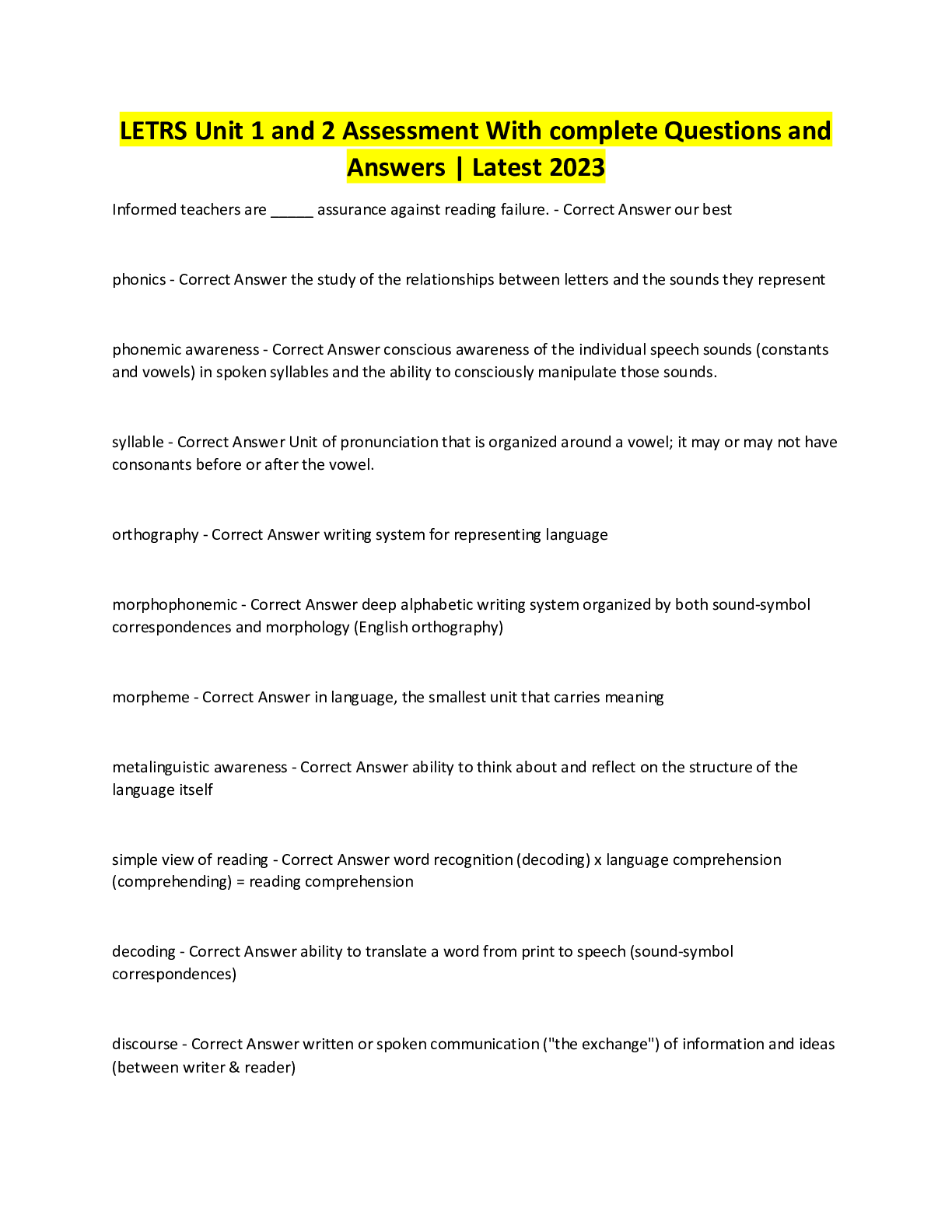*NURSING > EXAM > NCLEX RN Versions 1 -12 (Latest) With 850 Questions And Answers Guaranteed 100% Grade A. (All)
NCLEX RN Versions 1 -12 (Latest) With 850 Questions And Answers Guaranteed 100% Grade A.
Document Content and Description Below
NCLEX RN Versions 1 -12 (Latest) With 850 Questions And Answers Guaranteed 100% Grade A. 2022 Exam : NCLEX-RN Title : National Council Licensure Examination(NCLEX-RN) Ve... ndor : NCLEX Version : V12.35 NO.1 A depressed client is seen at the mental health center for follow-up after an attempted suicide 1 week ago. She has taken phenelzine sulfate (Nardil), a monoamine oxidase (MAO) inhibitor, for 7 straight days. She states that she is not feeling any better. The nurse explains that the drug must accumulate to an effective level before symptoms are totally relieved. Symptom relief is expected to occur within: A. 10 days B. 2-4 weeks C. 2 months D. 3 months Answer: B Explanation: (A) This answer is incorrect. It can take up to 1 month for therapeutic effect of the medication. (B) This answer is correct. Because MAO inhibitors are slow to act, it takes 2-4 weeks before improvement of symptoms is noted. (C) This answer is incorrect. It can take up to 1 month for therapeutic effect of the medication. (D) This answer is incorrect. Therapeutic effects of the medication are noted within 1 month of drug therapy. NO.2 Cystic fibrosis is transmitted as an autosomal recessive trait. This means that: A. Mothers carry the gene and pass it to their sons B. Fathers carry the gene and pass it to their daughters C. Both parents must have the disease for a child to have the disease D. Both parents must be carriers for a child to have the disease Answer: D Explanation: (A) Cystic fibrosis is not an X-linked or sex-linked disease. (B) The only characteristic on the Y chromosome is the trait for hairy ears. (C) Both parents do not need to have the disease but must be carriers. (D) If a trait is recessive, two genes (one from each parent) are necessary to produce an affected child. NO.3 A 24-year-old client presents to the emergency department protesting "I am God." The nurse identifies this as a: A. Delusion B. Illusion C. Hallucination D. Conversion Answer: A Explanation: (A) Delusion is a false belief. (B) Illusion is the misrepresentation of a real, external sensory experience. (C) Hallucination is a false sensory perception involving any of the senses. (D) Conversion is the expression of intrapsychic conflict through sensory or motor manifestations. NO.4 In acute episodes of mania, lithium is effective in 1-2 weeks, but it may take up to 4 weeks, or even a few months, to treat symptoms fully. Sometimes an antipsychotic agent is prescribed during the first few days or weeks of an acute episode to manage severe behavioral excitement and acute psychotic symptoms. In addition to the lithium, which one of the following medications might the physician prescribe? A. Diazepam (Valium) B. Haloperidol (Haldol) C. Sertraline (Zoloft) D. Alprazolam (Xanax) Answer: B Explanation: (A) Diazepam is an antianxiety medication and is not designed to reduce psychotic symptoms. (B) Haloperidol is an antipsychotic medication and may be used until the lithium takes effect. (C) Sertraline is an antidepressant and is used primarily to reduce symptoms of depression. (D) Alprazolam is an antianxiety medication and is not designed to reduce psychotic symptoms. NO.5 A violent client remains in restraints for several hours. Which of the following interventions is most appropriate while he is in restraints? A. Give fluids if the client requests them. B. Assess skin integrity and circulation of extremities before applying restraints and as they are removed. C. Measure vital signs at least every 4 hours. D. Release restraints every 2 hours for client to exercise. Answer: D Explanation: (A) Fluids (nourishment) should be offered at regular intervals whether the client requests (or refuses) them or not. (B) Skin integrity and circulation of the extremities should be checked regularly while the client is restrained, not only before restraints are applied and after they are removed. (C) Vital signs should be checked at least every 2 hours. If the client remains agitated in restraints, vital signs should be monitored even more closely, perhaps every 1-2 hours. (D) Restraints should be released every 2 hours for exercise, one extremity at a time, to maintain muscle tone, skin and joint integrity, and circulation. NO.6 The pediatrician has diagnosed tinea capitis in an 8- year-old girl and has placed her on oral griseofulvin. The nurse should emphasize which of these instructions to the mother and/or child? A. Administer oral griseofulvin on an empty stomach for best results. B. Discontinue drug therapy if food tastes funny. C. May discontinue medication when the child experiences symptomatic relief. D. Observe for headaches, dizziness, and anorexia. Answer: D Explanation: (A) Giving the drug with or after meals may allay gastrointestinal discomfort. Giving the drug with a fatty meal (ice cream or milk) increases absorption rate. (B) Griseofulvin may alter taste sensations and thereby decrease the appetite. Monitoring of food intake is important, and inadequate nutrient intake should be reported to the physician. (C) The child may experience symptomatic relief after 48- 96 hours of therapy. It is important to stress continuing the drug therapy to prevent relapse (usually about 6 weeks). (D) The incidence of side effects is low; however, headaches are common. Nausea, vomiting, diarrhea, and anorexia may occur. Dizziness, although uncommon, should be reported to the physician. NO.7 A client with cirrhosis of the liver becomes comatose and is started on neomycin 300 mg q6h via nasogastric tube. The rationale for this therapy is to: A. Prevent systemic infection B. Promote diuresis C. Decrease ammonia formation D. Acidify the small bowel Answer: C Explanation: (A) Neomycin is an antibiotic, but this is not the Rationale for administering it to a client in hepatic coma. (B) Diuretics and salt-free albumin are used to promote diuresis in clients with cirrhosis of the liver. (C) Neomycin destroys the bacteria in the intestines. It is the bacteria in the bowel that break down protein into ammonia. (D) Lactulose is administered to create an acid environment in the bowel. Ammonia leaves the blood and migrates to this acidic environment where it is trapped and excreted. NO.8 A 5-year-old has just had a tonsillectomy and adenoidectomy. Which of these nursing measures should be included in the postoperative care? A. Encourage the child to cough up blood if present. B. Give warm clear liquids when fully alert. C. Have child gargle and do toothbrushing to remove old blood. D. Observe for evidence of bleeding. Answer: D Explanation: (A) The nurse should discourage the child from coughing, clearing the throat, or putting objects in his mouth. These may induce bleeding. (B) Cool, clear liquids may be given when child is fully alert. Warm liquids may dislodge a blood clot. The nurse should avoid red- or brown-colored liquids to distinguish fresh or old blood from ingested liquid should the child vomit. (C) Gargles and vigorous toothbrushing could initiate bleeding. (D) Postoperative hemorrhage, though unusual, may occur. The nurse should observe for bleeding by looking directly into the throat and for vomiting of bright red blood, continuous swallowing, and changes in vital signs. NO.9 An 80-year-old male client with a history of arteriosclerosis is experiencing severe pain in his left leg that started approximately 20 minutes ago. When performing the admission assessment, the nurse would expect to observe which of the following: A. Both lower extremities warm to touch with 2_pedal pulses B. Both lower extremities cyanotic when placed in a dependent position C. Decreased or absent pedal pulse in the left leg D. The left leg warmer to touch than the right leg Answer: C Explanation: (A) This statement describes a normal assessment finding of the lower extremities. (B) This assessment finding reflects problems caused by venous insufficiency. (C) Decreased or absentpedal pulses reflect a problem caused by arterial insufficiency. (D) The leg that is experiencing arterial insufficiency would be cool to touch due to the decreased circulation. NO.10 A 16-month-old infant is being prepared for tetralogy of Fallot repair. In the nursing assessment, which lab value should elicit further assessment and requires notification of physician? A. pH 7.39 B. White blood cell (WBC) count 10,000 WBCs/mm3 C. Hematocrit 60% D. Bleeding time of 4 minutes Answer: C Explanation: (A) Normal pH of arterial blood gases for an infant is 7.35-7.45. (B) Normal white blood cell count in an infant is 6,000-17,500 WBCs/mm3. (C) Normal hematocrit in infant is 28%-42%. A 60% hematocrit may indicate polycythemia, a common complication of cyanotic heart disease. (D) Normal bleeding time is 2-7 minutes. NO.11 A male client is experiencing extreme distress. He begins to pace up and down the corridor. What nursing intervention is appropriate when communicating with the pacing client? A. Ask him to sit down. Speak slowly and use short, simple sentences. B. Help him to recognize his anxiety. C. Walk with him as he paces. D. Increase the level of his supervision. Answer: C Explanation: (A) The nurse should not ask him to sit down. Pacing is the activity he has chosen to deal with his anxiety. The nurse dealing with this client should speak slowly and with short, simplesentences. (B) The client may already recognize the anxiety and is attempting to deal with it. (C) Walk with the client as he paces. This gives support while he uses anxiety-generated energy. (D) Increasing the level of supervision may be appropriate after he stops pacing. It would minimize self-injury and/or loss of control. NO.12 Prior to an amniocentesis, a fetal ultrasound is done in order to: A. Evaluate fetal lung maturity B. Evaluate the amount of amniotic fluid C. Locate the position of the placenta and fetus D. Ensure that the fetus is mature enough to perform the amniocentesis Answer: C Explanation: (A) Amniocentesis can be performed to assess for lung maturity. Fetal ultrasound can be used for gestational dating, although it does not separately determine lung maturity. (B) Ultrasound can evaluate amniotic fluid volume, which may be used to determine congenital anomalies. (C) Amniocentesis involves removal of amniotic fluid for evaluation. The needle, inserted through the abdomen, is guided by ultrasound to avoid needle injuries, and the test evaluates the position of the placenta and the fetus. (D) Amniocentesis can be performed as early as the 15th-17th week of pregnancy. NO.13 A 25-year-old client believes she may be pregnant with her first child. She schedules an obstetric examination with the nurse practitioner to determine the status of her possible pregnancy. Her last menstrual period began May 20, and her estimated date of confinement using Nagele's rule is: A. March 27 B. February 1 C. February 27 D. January 3 Answer: C Explanation: (A)March 27 is a miscalculation. (B) February 1 is a miscalculation. (C) February 27 is the correct answer. To calculate the estimated date of confinement using Nagele's rule, subtract 3 months from the date that the last menstrual cycle began and then add 7 days to the result. (D) January 3 is a miscalculation. NO.14 A client is now pregnant for the second time. Her first child weighed 4536 g at delivery. The client's glucose tolerance test shows elevated blood sugar levels. Because she only shows signs of diabetes when she is pregnant, she is classified as having: A. Insulin-dependent diabetes B. Type II diabetes mellitus C. Type I diabetes mellitus D. Gestational diabetes mellitus Answer: D Explanation: (A) Insulin-dependent diabetes mellitus, also known as type I diabetes, usually appears before the age of 30 years with an abrupt onset of symptoms requiring insulin for management. It is not related to onset during pregnancy. (B) Non-insulin-dependent diabetes (type II diabetes) usually appears in older adults. It has a slow onset and progression of symptoms. (C) This type of diabetes is the same as insulin-dependent diabetes. (D) Gestational diabetes mellitus has its onset of symptoms during pregnancy and usually disappears after delivery. These symptoms are usually mild and not life threatening, although they are associated with increased fetal morbidity and other fetal complications. NO.15 A 44-year-old female clie [Show More]
Last updated: 1 year ago
Preview 1 out of 317 pages

Reviews( 0 )
Document information
Connected school, study & course
About the document
Uploaded On
Jul 13, 2022
Number of pages
317
Written in
Additional information
This document has been written for:
Uploaded
Jul 13, 2022
Downloads
0
Views
31


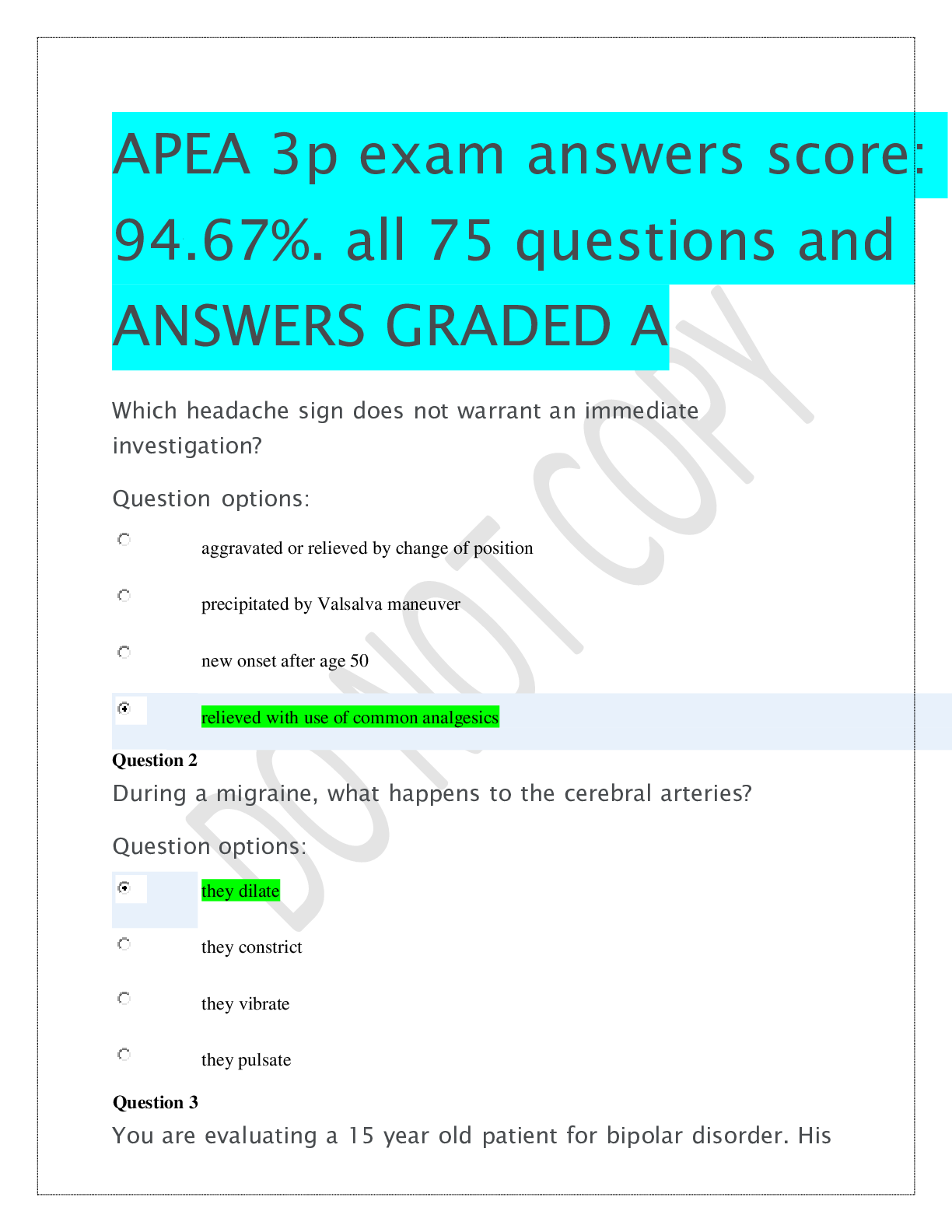


.png)
.png)

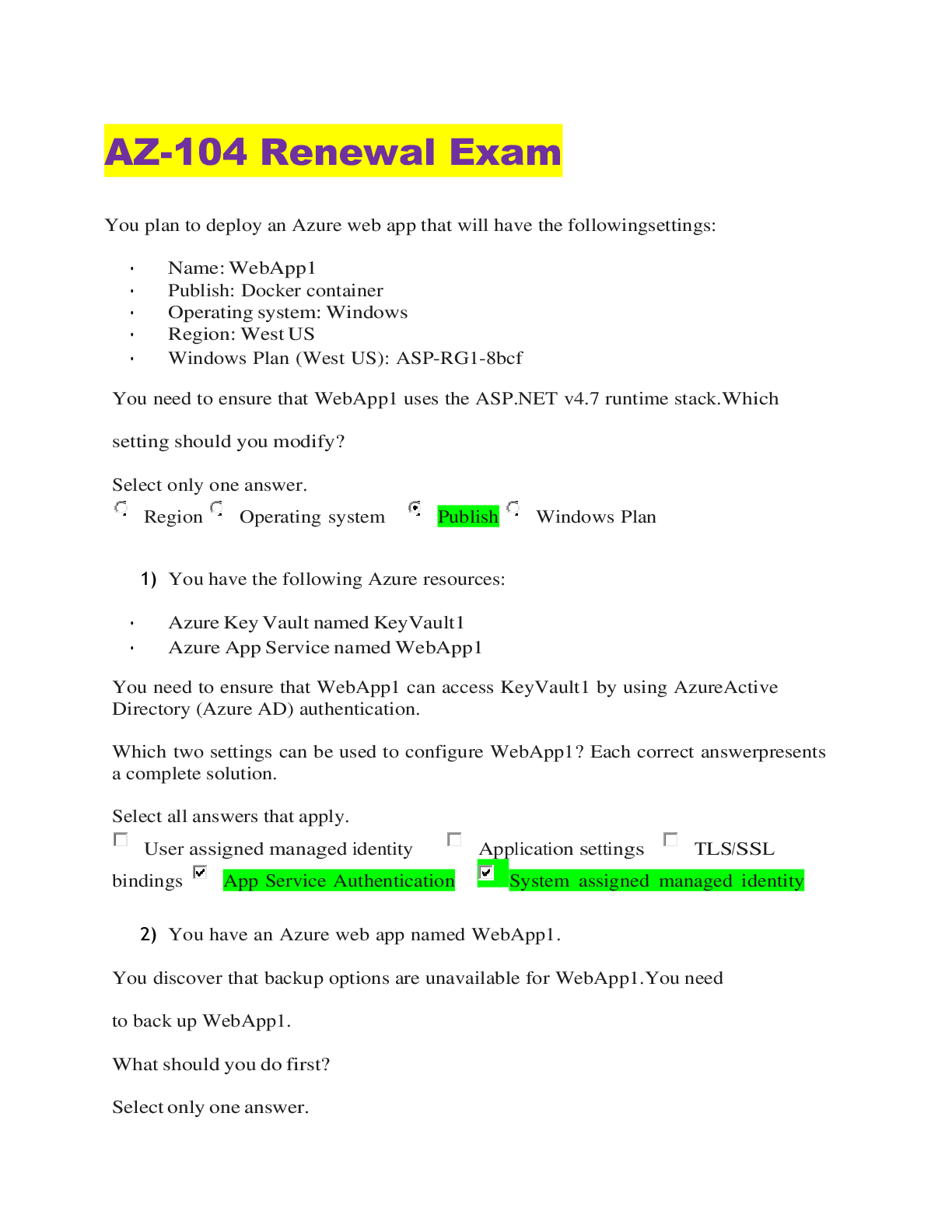


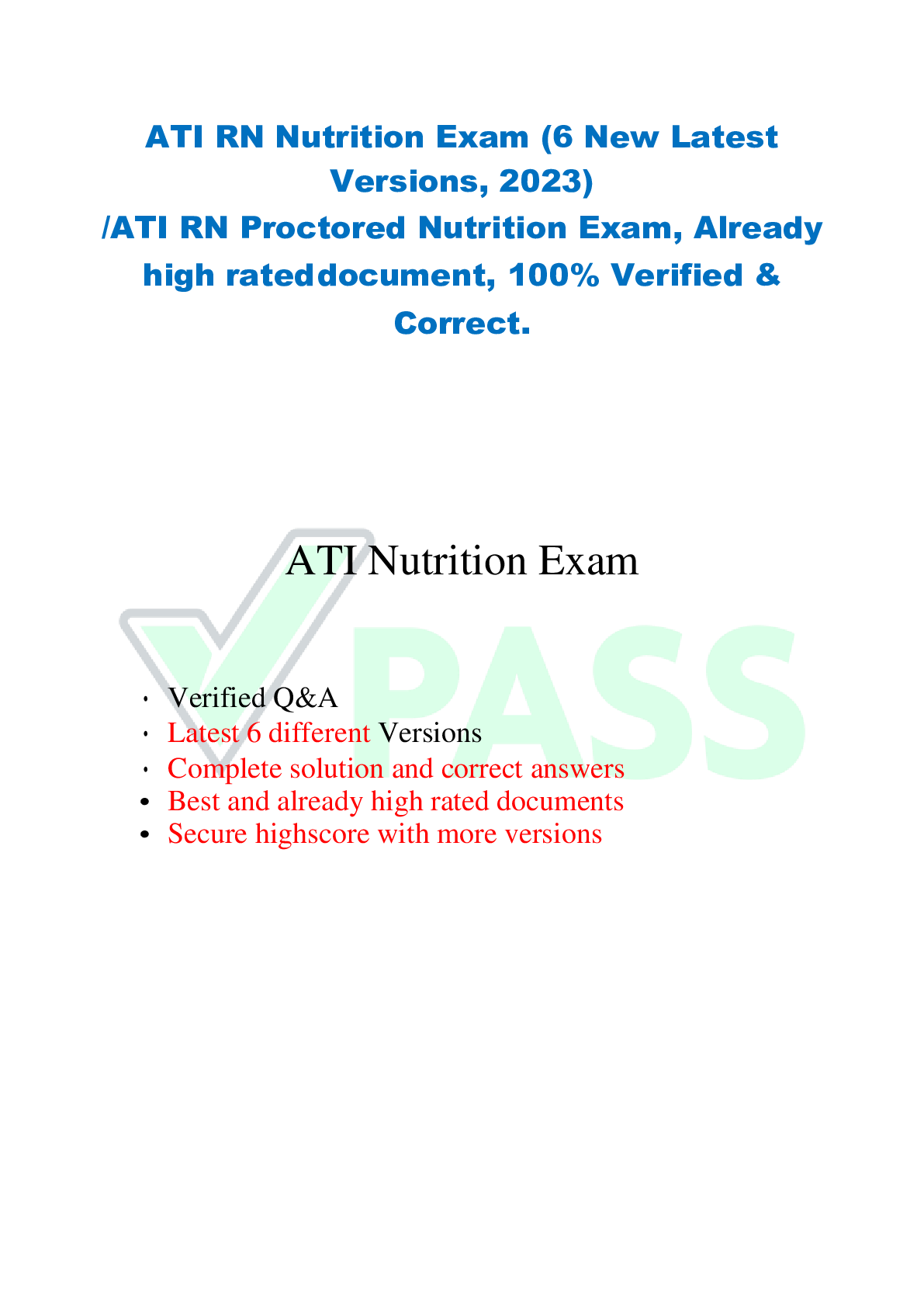

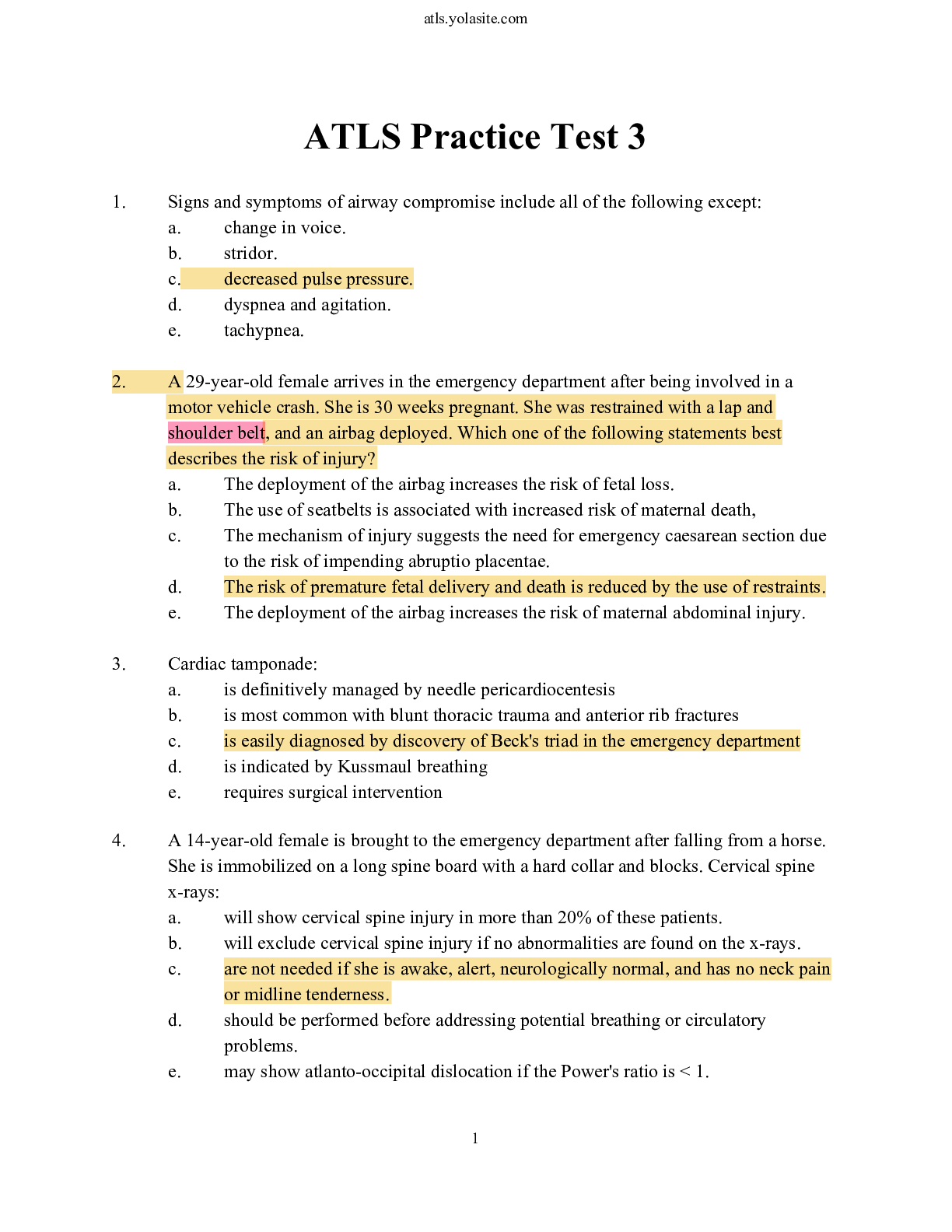





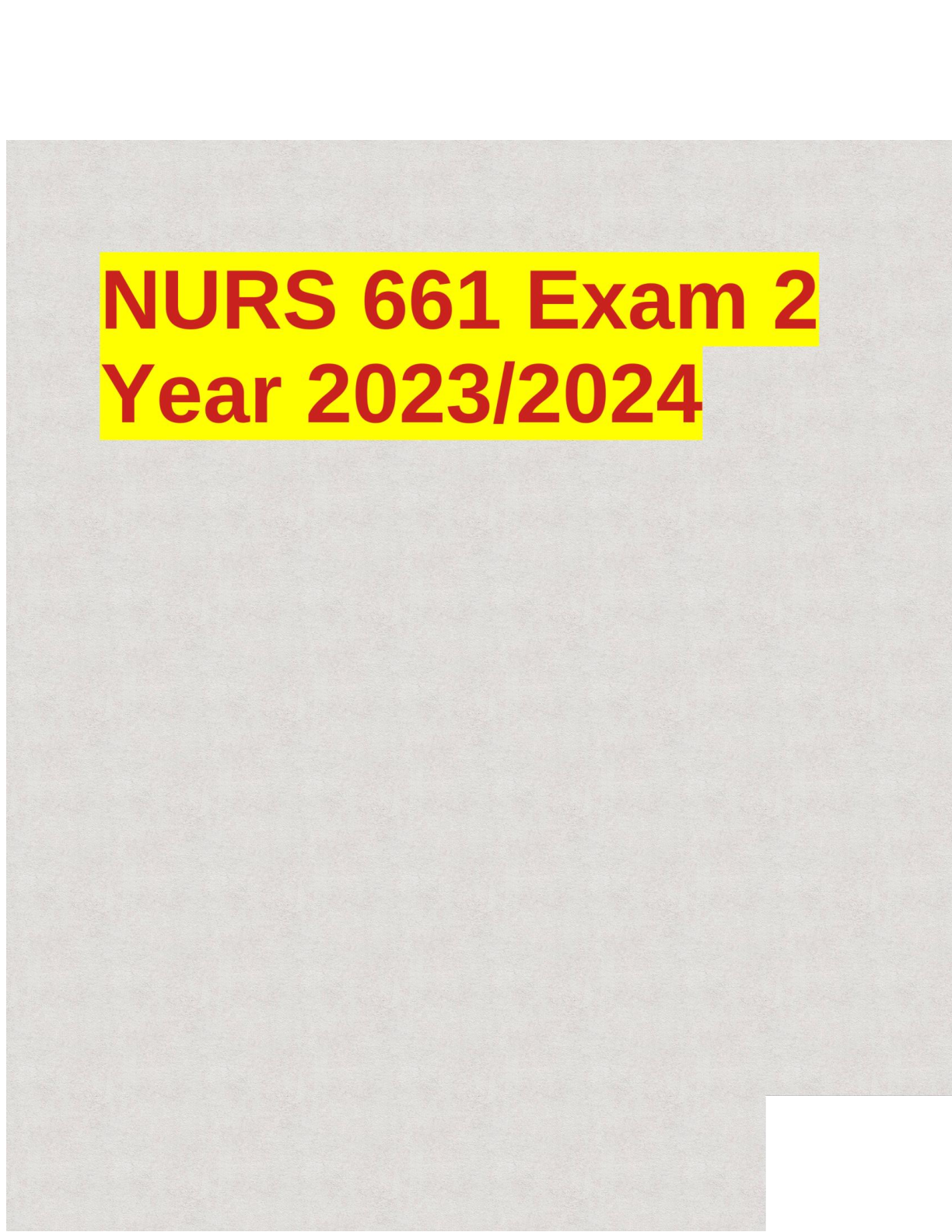



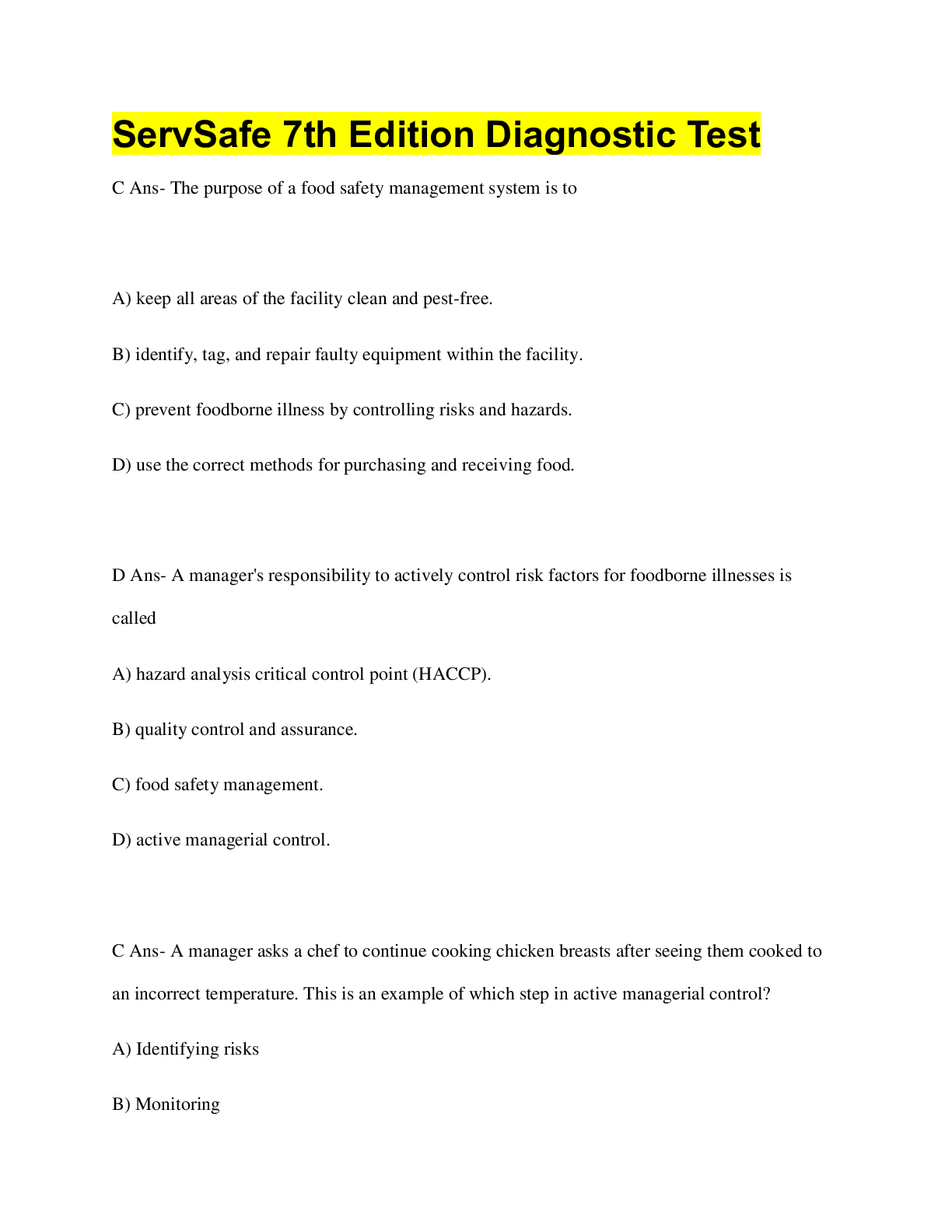
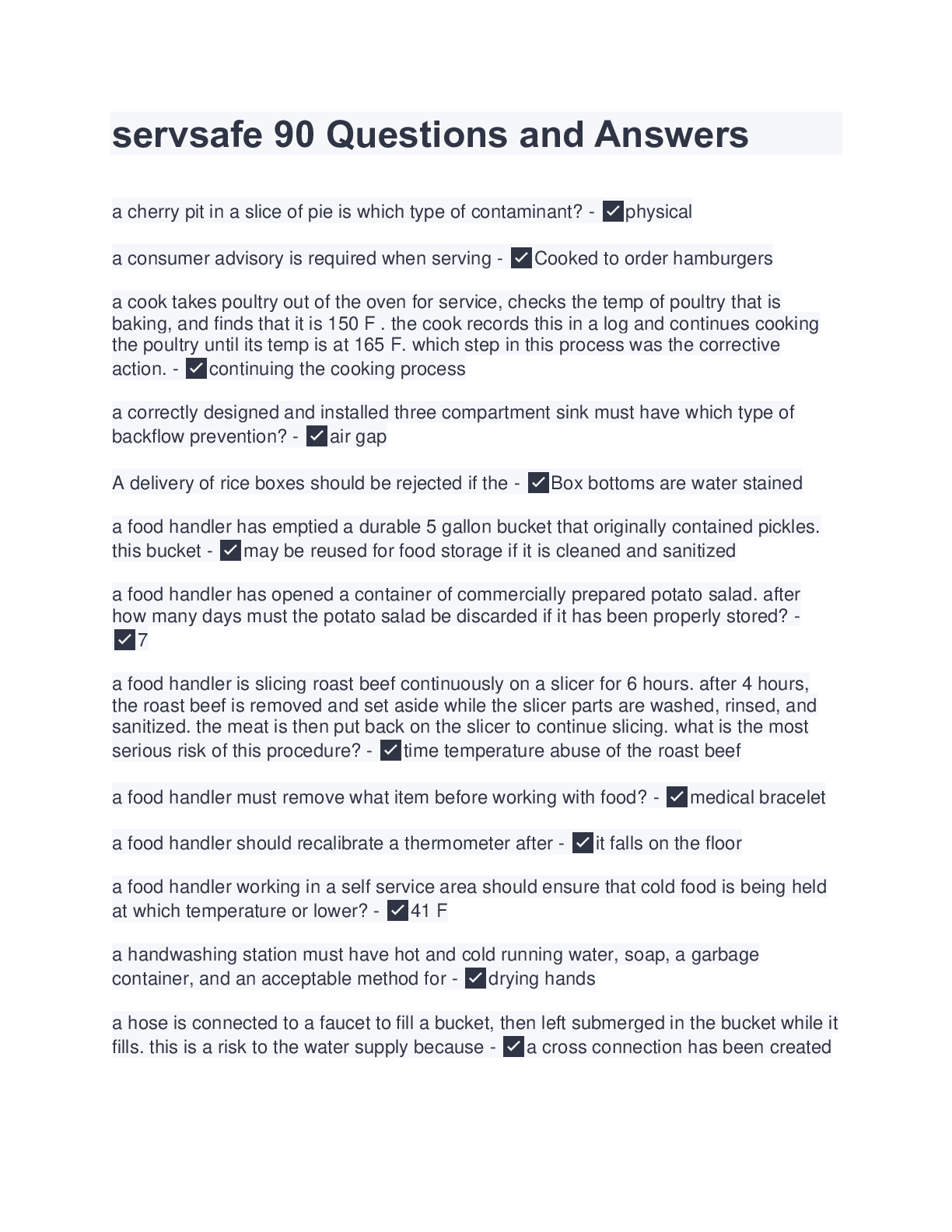
.png)







